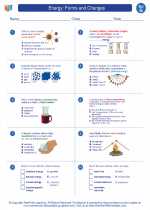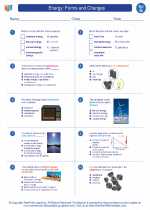Buoyancy
Buoyancy is the ability of an object to float in a fluid, such as water or air. It is a result of the upward force exerted by the fluid on the object.
Principle of Buoyancy
The principle of buoyancy is based on Archimedes' principle, which states that the buoyant force acting on an object submerged in a fluid is equal to the weight of the fluid displaced by the object.
Factors Affecting Buoyancy
- Volume: The greater the volume of an object, the greater the buoyant force acting on it.
- Density: An object with a lower density than the fluid will float, while an object with a higher density will sink.
- Fluid Density: The denser the fluid, the greater the buoyant force acting on the object.
Applications of Buoyancy
Buoyancy has various practical applications, including the design of ships, submarines, hot air balloons, and life jackets.
Study Guide
Here are some key points to remember when studying buoyancy:
.◂Science Worksheets and Study Guides Seventh Grade. Energy: Forms and Changes
Worksheet/Answer key Energy: Forms and Changes
Energy: Forms and Changes  Worksheet/Answer key
Worksheet/Answer key Energy: Forms and Changes
Energy: Forms and Changes  Worksheet/Answer key
Worksheet/Answer key Energy: Forms and Changes
Energy: Forms and Changes  Vocabulary/Answer key
Vocabulary/Answer key Energy: Forms and Changes
Energy: Forms and Changes  Vocabulary/Answer key
Vocabulary/Answer key Energy: Forms and Changes
Energy: Forms and Changes  Vocabulary/Answer key
Vocabulary/Answer key Energy: Forms and Changes
Energy: Forms and Changes 

 Worksheet/Answer key
Worksheet/Answer key
 Worksheet/Answer key
Worksheet/Answer key
 Vocabulary/Answer key
Vocabulary/Answer key
 Vocabulary/Answer key
Vocabulary/Answer key
 Vocabulary/Answer key
Vocabulary/Answer key

The resources above cover the following skills:
Skills and Processes: Students will demonstrate the thinking and acting inherent in the practice of science.
Constructing Knowledge: Design, analyze, or carry out simple investigations and formulate appropriate conclusions based on data obtained or provided.
Use mathematics to interpret and communicate data.